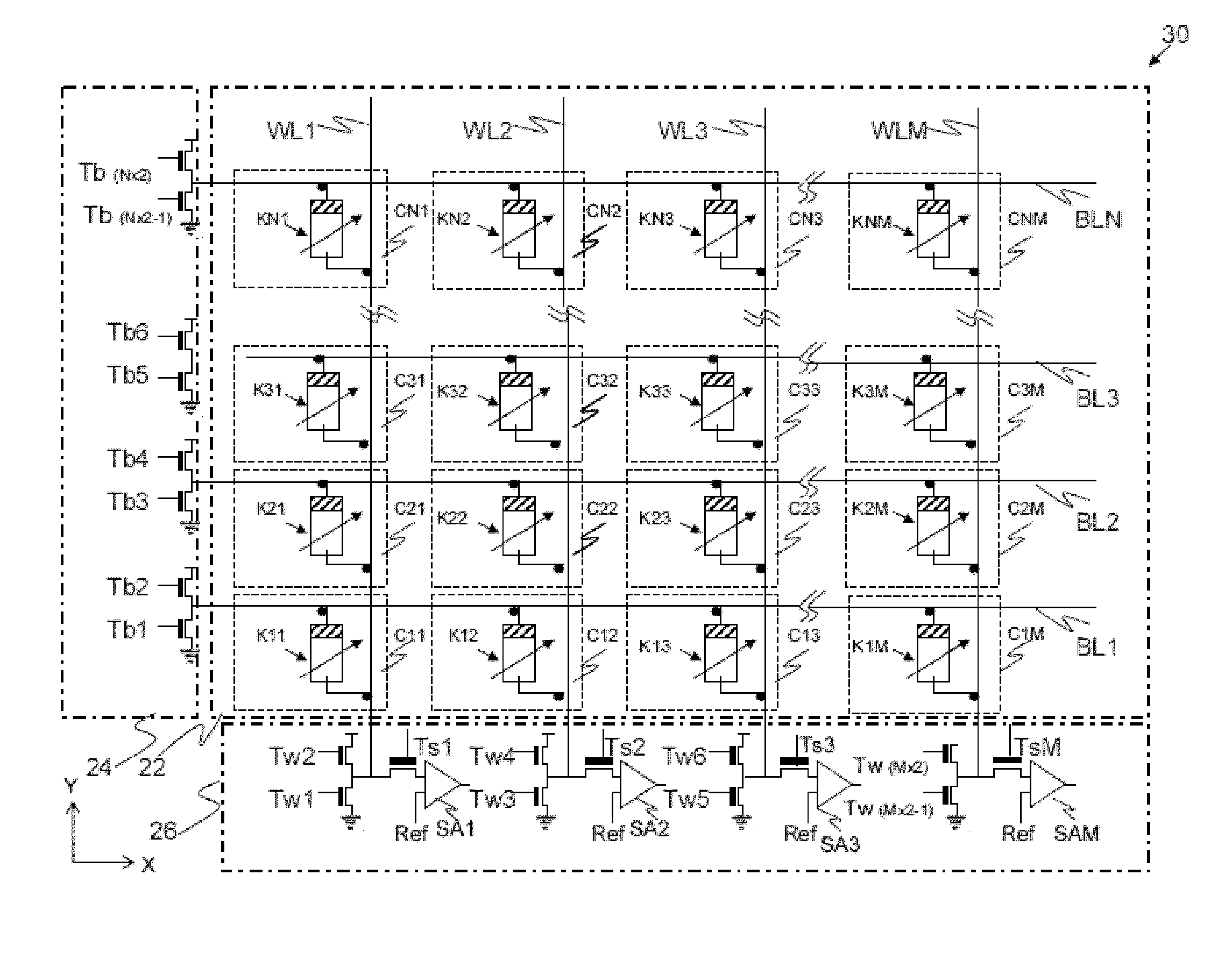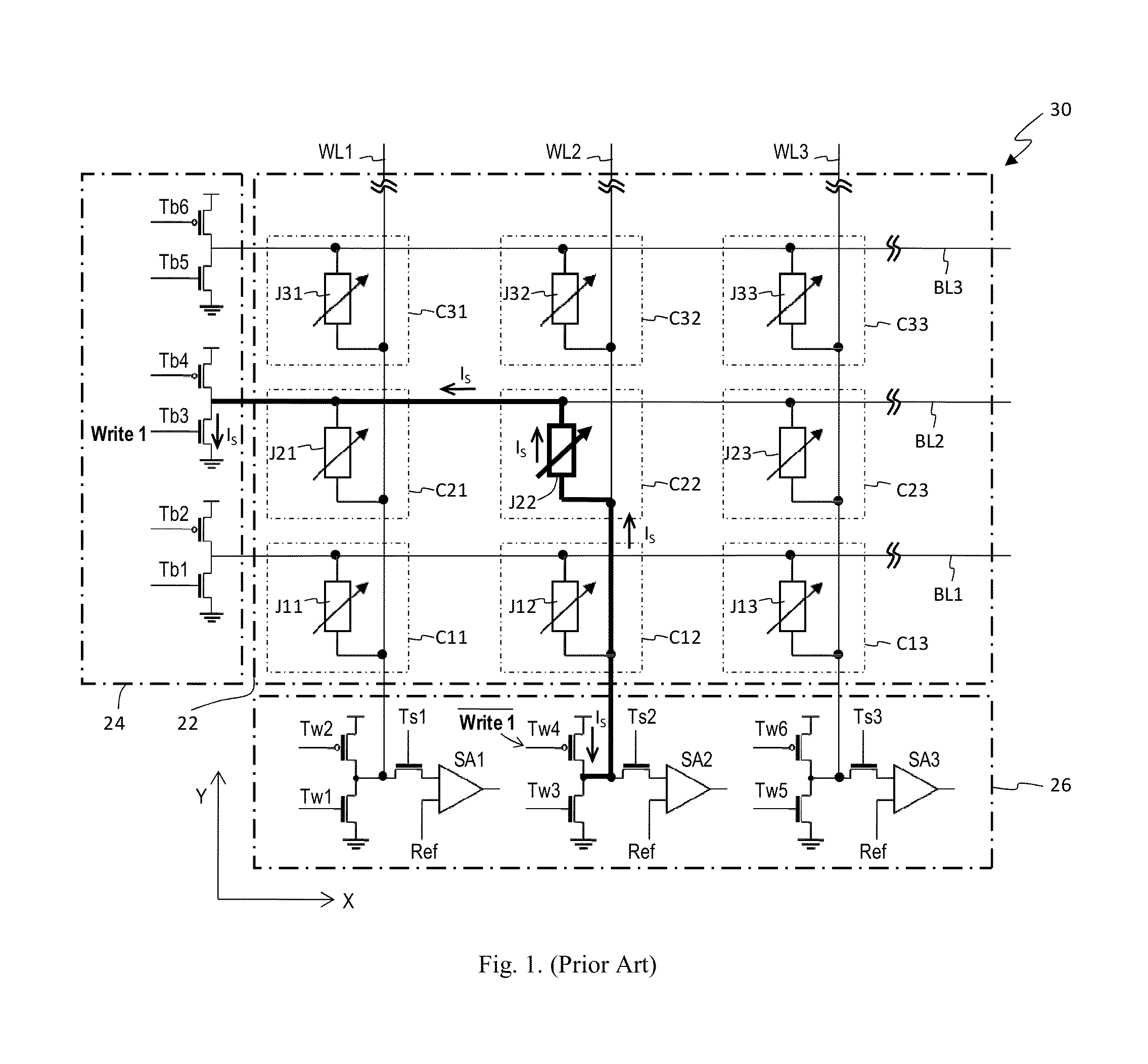Low Cost High Density Nonvolatile Memory Array Device Employing Thin Film Transistors and Back to Back Schottky Diodes
- Summary
- Abstract
- Description
- Claims
- Application Information
AI Technical Summary
Benefits of technology
Problems solved by technology
Method used
Image
Examples
first embodiment
[0110]FIG. 7 is a cross section view of a three-dimensional memory array made in accordance with a first embodiment of the present invention. Memory arrays (63) are cross-point MRAM arrays made according to FIG. 6 whereby a BBSD is incorporated into each memory element. A silicon wafer substrate (60) is provided with CMOS circuitry (61) fabricated on the substrate. Such circuitry is fabricated at a technology node (Fc) which may be the same size as the technology node for the MTJ layers (Fm) or smaller or larger, depending on the nature of the CMOS circuitry. For example, a microprocessor or high end FPGA may be fabricated at a smaller technology node Fc compared to the embedded memory array (Fm) which resides above the circuitry. This embedded memory is lower cost than a separate chip and provides for higher speeds as no off chip delays a required. Lower power consumption is also realized due to the reduced circuitry. On the other hand, a stand alone memory device may have a larger...
second embodiment
[0111]FIG. 8 is a cross section view of a three-dimensional memory array made in accordance with a second embodiment of the present invention. Memory arrays (63) are cross-point MRAM arrays made according to FIG. 6 whereby a BBSD is incorporated into each memory element. A low cost glass substrate (70) is provided with the first thin film transistor layer (TFT-L1) circuitry fabricated on the substrate. Such circuitry is fabricated at a technology node (Ft) which may be the same size as the technology node for the MTJ layers (Fm) but preferably for cost savings may be larger than Fm. Such circuitry may include the bandgap and decoder logic for the memory arrays (63), as well as selection transistors for the first memory array (MTJ-L1). Additional circuitry for the memory arrays (MTJ-L1-MTJ-Ln) is provided in various additional layers (64) of thin film transistors (TFT-L2-TFT-Ln+1) disposed between the memory arrays. The TFT circuitry is fabricated at a technology node (Ft) substantia...
third embodiment
[0112]FIG. 9 is a cross section view of a three-dimensional memory array made in accordance with a third embodiment of the present invention. Memory arrays (63) are cross-point MRAM arrays made according to FIG. 6 whereby a BBSD is incorporated into each memory element. A low cost glass substrate (70) is provided with the first thin film transistor layer (TFT-L1) circuitry fabricated on the substrate. Such circuitry is fabricated at a technology node (Ft) which may be the same size as the technology node for the MTJ layers (Fm) but preferably for cost savings may be larger than Fm. Such circuitry may include the bandgap and decoder logic for the memory arrays (63), as well as selection transistors for the first memory array (MTJ-L1). Additional circuitry for the memory arrays (MTJ-L1-MTJ-Ln) is provided in various additional layers (64) of thin film transistors (TFT-L2-TFT-L(n / 2+1) disposed between every two memory arrays. The TFT circuitry is fabricated at a technology node (Ft) su...
PUM
 Login to View More
Login to View More Abstract
Description
Claims
Application Information
 Login to View More
Login to View More - R&D
- Intellectual Property
- Life Sciences
- Materials
- Tech Scout
- Unparalleled Data Quality
- Higher Quality Content
- 60% Fewer Hallucinations
Browse by: Latest US Patents, China's latest patents, Technical Efficacy Thesaurus, Application Domain, Technology Topic, Popular Technical Reports.
© 2025 PatSnap. All rights reserved.Legal|Privacy policy|Modern Slavery Act Transparency Statement|Sitemap|About US| Contact US: help@patsnap.com



